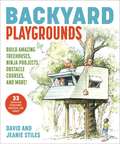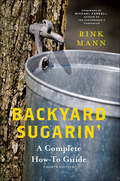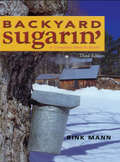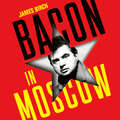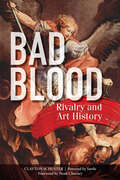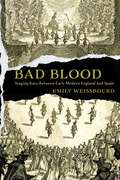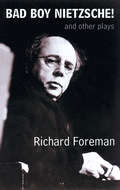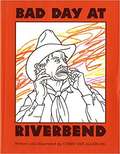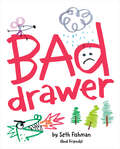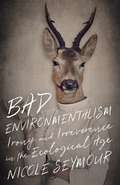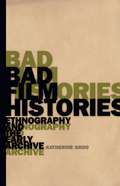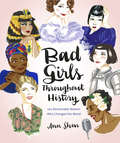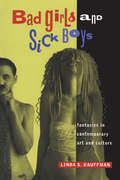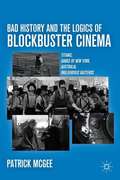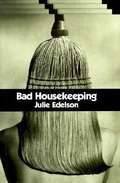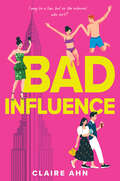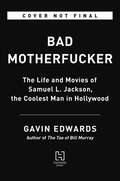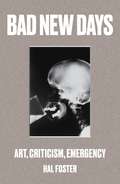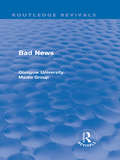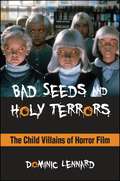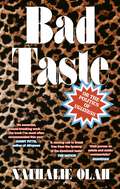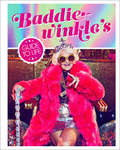- Table View
- List View
Backyard Playgrounds: Build Amazing Treehouses, Ninja Projects, Obstacle Courses, and More!
by David Stiles Jeanie StilesBuild your own treehouses, swing sets, skate ramps, Ninja courses, and more! Kids and families of all ages are rediscovering the great outdoors, including their own backyards. It is more important than ever to be able to entertain our kids at home, teach them about nature, and give them a great time building, exercising, staying in shape, and working together. All of these actions help foster independence, confidence, and growth. In Do-It-Yourself Backyard Playgrounds, authors Jean and David Stiles offer user-friendly plans (all hand-drawn by David) and step-by-step instructions to help you build something great in your own backyard. They offer a range of easy, timeless projects that can be made in an afternoon—trolley ride, treasure chest, circle swing, lemonade stand—alongside more ambitious projects, like the warped wall and treehouse. Learn how to build a complete Ninja adventure course and see how the treehouse can double as a home base for the adventure course that radiates from it! The book includes photos of projects (during construction and completed), and explanatory step-by-step illustrations.
Backyard Rockets: Learn to Make and Launch Rockets, Missiles, Cannons, and Other Projectiles
by Instructables. Com Mike WarrenOriginating from Instructables, a popular project-based community made up of all sorts of characters with wacky hobbies and a desire to pass on their wisdom to others, Backyard Rockets is made up of projects from a medley of authors who have collected and shared a treasure trove of rocket-launching plans and the knowledge to make their projects soar!Backyard Rockets gives step-by-step instructions, with pictures to guide the way, on how to launch your very own project into the sky. All of these authors have labored over their endeavors to pass their knowledge on and make it easier for others to attempt. Discover how to create the following projects:Teeny, Tiny Rocket EngineUltimate Straw RocketRocket EggstronautPocket Rocket LauncherIron Man Model RocketModel Rocket with CameraRocket-Powered Matchbox Cars - ExtremeAnd much more!The Instructables community has provided a compendium of rocket savvy from innovators who have paved the way for other curious minds. In addition to rockets, fireworks, and launchers in Backyard Rockets, you will discover the sense of accomplishment after watching your rocket soar into the sky!
Backyard Sugarin': A Complete How-To Guide (4th Edition)
by Rink Mann Michael FarrellFrom buying equipment to tapping your own trees to boiling the sap, this is the classic, best-selling guide to making maple syrup This little book swept maple sugarin’ buffs off their feet when it first appeared and is still the top-selling guide to the craft after over 40 years in print. Backyard Sugarin’ tells you how you can make maple syrup right in your own backyard without having to build a sap house or buy buckets, holding tanks, evaporators, and other expensive paraphernalia. This new edition also features a foreword by maple expert Michael Farrell, author of The Sugarmaker’s Companion, who provides a contemporary look back at the old-school techniques presented in this book. With detailed “how-to” information and tips from sugarers across the country, this is the only maple sugaring guide you’ll ever need.
Backyard Sugarin': A Complete How-To Guide (Third Edition)
by Rink Mann<P> From buying equipment to tapping your own trees to boiling the sap, this is the classic, best-selling guide to making maple syrup. <P> This little book swept maple sugarin' buffs off their feet when it first appeared and is still the top-selling guide to the craft after nearly 30 years in print. Like the previous editions, this one tells you how you can make maple syrup right in your own backyard without having to build a sap house or buy buckets, holding tanks, evaporators and other expensive paraphernalia. Provides detailed "how-to" information, and makes some new and noteworthy revelations-including tips sugarers across the country have shared with the author.
Bacon in Moscow
by James Birch'A rollicking cultural adventure before the fall of the Berlin Wall and the meteoric rise of contemporary art in the nineties' Grayson PerryThis funny and personal memoir is the account of an audacious attempt by James Birch, a young British curator, to mount the ground-breaking retrospective of Francis Bacon's work at the newly refurbished Central House of Artists, Moscow in 1988.Side-lined by the British establishment, Birch found himself at the heart of a honey-trap and the focus for a picaresque cast of Soviet officials, attachés and politicians under the forbidding eye of the KGB as he attempted to bring an unseen western cultural icon to Russia during the time of 'Glasnost', just before the fall of the Berlin Wall.Bacon in Moscow is the story of the evolution of an exhibition that was at the artistic and political heart of a sea of change that culminated with the fall of the USSR.
Bad Blood: Rivalry and Art History
by Clayton SchusterWhy is there so much bad blood involved in the stories of artists and their artworks? Immerse yourself in 18 infamous artistic rivalries, dramatized with gripping moments of narrative, to understand how the rivalries that art fans love to gossip about serve a larger purpose in the way cultures approach the idea of art and the artist. Why did Michelangelo loathe Raphael for decades after the latter had died? How did Pablo Picasso and Henri Matisse balance their perpetual competition with a lifelong friendship? What transgression pitted the notorious titans of the London graffiti scene, Banksy and King Robbo, in a rivalry that ended with a tragic and unforeseeable death? An investigative journey transforms some of the “big names” of the art world into real people—often grumpy, ornery, antagonistic, and flawed—and better reveals how all of us respond to art.
Bad Blood: Staging Race Between Early Modern England and Spain (RaceB4Race: Critical Race Studies of the Premodern)
by Emily WeissbourdBad Blood explores representations of race in early modern English and Spanish literature, especially drama. It addresses two different forms of racial ideology: one concerned with racialized religious difference—that is, the notion of having Jewish or Muslim “blood”—and one concerned with Blackness and whiteness. Shakespeare’s Othello tells us that he was “sold to slavery” in his youth, a phrase that evokes the Atlantic triangle trade for readers today. For many years, however, scholars have asserted that racialized slavery was not yet widely understood in early modern England, and that the kind of enslavement that Othello describes is related to Christian-Muslim conflict in the Mediterranean rather than the rise of the racialized enslavement of Afro-diasporic subjects.Bad Blood offers a new account of early modern race by tracing the development of European racial vocabularies from Spain to England. Dispelling assumptions, stemming from Spain’s historical exclusion of Jews and Muslims, that premodern racial ideology focused on religious difference and purity of blood more than color, Emily Weissbourd argues that the context of the Atlantic slave trade is indispensable to understanding race in early modern Spanish and English literature alike. Through readings of plays by Shakespeare, Lope de Vega, and their contemporaries, as well as Spanish picaresque fiction and its English translations, Weissbourd reveals how ideologies of racialized slavery as well as religious difference come to England via Spain, and how both notions of race operate in conjunction to shore up fantasies of Blackness, whiteness, and “pure blood.” The enslavement of Black Africans, Weissbourd shows, is inextricable from the staging of race in early modern literature.
Bad Boy
by Michael Stone Eric FischlIn Bad Boy, renowned American artist Eric Fischl has written a penetrating, often searing exploration of his coming of age as an artist, and his search for a fresh narrative style in the highly charged and competitive New York art world in the 1970s and 1980s. With such notorious and controversial paintings as Bad Boy and Sleepwalker, Fischl joined the front ranks of America artists, in a high-octane downtown art scene that included Andy Warhol, David Salle, Julian Schnabel, and others. It was a world of fashion, fame, cocaine and alcohol that for a time threatened to undermine all that Fischl had achieved. In an extraordinarily candid and revealing memoir, Fischl discusses the impact of his dysfunctional family on his art--his mother, an imaginative and tragic woman, was an alcoholic who ultimately took her own life. Following his years as a student at Cal Arts and teaching in Nova Scotia, he describes his early years in New York with the artist April Gornik, just as Wall Street money begins to encroach on the old gallery system and change the economics of the art world. Fischl rebelled against the conceptual and minimalist art that was in fashion at the time to paint compelling portraits of everyday people that captured the unspoken tensions in their lives. Still in his thirties, Eric became the subject of a major Vanity Fair interview, his canvases sold for as much as a million dollars, and The Whitney Museum mounted a major retrospective of his paintings. Bad Boy follows Fischl's maturation both as an artist and sculptor, and his inevitable fall from grace as a new generation of artists takes center stage, and he is forced to grapple with his legacy and place among museums and collectors. Beautifully written, and as courageously revealing as his most provocative paintings, Bad Boy takes the reader on a roller coaster ride through the passion and politics of the art world as it has rarely been seen before.
Bad Boy Nietzsche! and Other Plays
by Richard ForemanRichard Foreman has been at the leading edge of the theatrical avant-garde in the United States and throughout the world since 1968. His legendary productions, written and directed by him at his Ontological-Hysteric Theatre have influenced two generations of theater artists. This new anthology collects plays written and performed over six years, including Now That Communism Is Dead My Life Feels Empty, Maria del Bosco, Panic (How to Be Happy!), Bad Boy Nietzsche!, Bad Behavior and King Cowboy Rufus Rules the Universe.Richard Foreman founded the Ontological-Hysteric Theatre in 1968. The theater is currently in the historic St. Marks Church, where he rehearses and produces one of his new plays each year, each play performing for 16 weeks every winter.
Bad Day At Riverbend
by Chris Van AllsburgVan Allsburg cuts loose with this inventive spoof that will keep readers guessing right up to the end of what the whole slimy shining thing is. Van Allsburg clearly had fun with this one, and readers likely will too.
Bad Drawer
by Seth Fishman&“The Stone Soup of collaborative creativity—eight thumbs up!&”—Jessica Love, author of Julián Is a Mermaid"Bad Drawer is inspiring for every kind of drawer, and it is such a fun, creative way to show what can happen when we work together with our friends." —Nathan Pyle, #1 New York Times bestselling creator of Strange Planet A hilarious and gorgeous picture book by A Hundred Billion Trillion Stars author Seth Fishman, following a bad drawer who works together with his friends to help bring his wildest stories to life.Seth has a super fantastic story in his head. A story so completely awesome and unbelievably amazing that he needs to get it out on paper and share it with the world right away. There's only one problem: He's a bad drawer. Like, really bad. He's tried and tried, but his illustrations are never quite like he imagined when they actually land on the page.But he has an idea that might fix things: What if his friends help him bring his story to life? A delightful picture book featuring work from award-winning illustrators Jessixa Bagley, Armand Baltazar, Anna Bond, Travis Foster, Jessica Hische, Tillie Walden, and Ethan Young, Bad Drawer will make readers laugh out loud and embrace their flaws -- while also having quite a bit of fun in the process.
Bad Environmentalism: Irony and Irreverence in the Ecological Age
by Nicole SeymourTraces a tradition of ironic and irreverent environmentalism, asking us to rethink the movement&’s reputation for gloom and doomActivists today strive to educate the public about climate change, but sociologists have found that the more we know about alarming issues, the less likely we are to act. Meanwhile, environmentalists have acquired a reputation as gloom-and-doom killjoys. Bad Environmentalism identifies contemporary texts that respond to these absurdities and ironies through absurdity and irony—as well as camp, frivolity, irreverence, perversity, and playfulness. Nicole Seymour develops the concept of &“bad environmentalism&”: cultural thought that employs dissident affects and sensibilities to reflect critically on our current moment and on mainstream environmental activism. From the television show Wildboyz to the short film series Green Porno, Seymour shows that this tradition of thought is widespread—spanning animation, documentary, fiction film, performance art, poetry, prose fiction, social media, and stand-up comedy since at least 1975. Seymour argues that these texts reject self-righteousness and sentimentality, undercutting public negativity toward activism and questioning basic environmentalist assumptions: that love and reverence are required for ethical relationships with the nonhuman and that knowledge is key to addressing problems like climate change.Funny and original, Bad Environmentalism champions the practice of alternative green politics. From drag performance to Indigenous comedy, Seymour expands our understanding of how environmental art and activism can be pleasurable, even in a time of undeniable crisis.
Bad Film Histories: Ethnography and the Early Archive
by Katherine GrooA daring, deep investigation into ethnographic cinema that challenges standard ways of writing film history and breaks important new ground in understanding archives Bad Film Histories is a vital work that unsettles the authority of the archive. Katherine Groo daringly takes readers to the margins of the film record, addressing the undertheorization of film history and offering a rigorous corrective. Taking ethnographic cinema as a crucial case study, Groo challenges standard ways of thinking and writing about film history and questions widespread assumptions about what film artifacts are and what makes them meaningful. Rather than filling holes, Groo endeavors to understand the imprecisions and absences that define film history and its archives. Bad Film Histories draws on numerous works of ethnographic cinema, from Edward S. Curtis&’s In the Land of the Head Hunters, to a Citroën-sponsored &“croisière&” across Africa, to the extensive archives of the Maison Lumière and the Musée Albert-Kahn, to dozens of expedition films from the 1910s and 1920s. The project is deeply grounded in poststructural approaches to history, and throughout Groo draws on these frameworks to offer innovative and accessible readings that explain ethnographic cinema&’s destabilizing energies.As Groo describes, ethnographic works are mostly untitled, unauthored, seemingly infinite in number, and largely unrestored even in their digital afterlives. Her examination of ethnographic cinema provides necessary new thought for both film scholars and those who are thrilled by cinema&’s boundless possibilities. In so doing, she boldly reexamines what early ethnographic cinema is and how these films produce meaning, challenging the foundations of film history and prevailing approaches to the archive.
Bad Girls Throughout History: 100 Remarkable Women Who Changed the World
by Ann ShenBad Girls Throughout History: 100 Remarkable Women Who Changed the World delivers a empowering book for women and girls of all ages, featuring 100 women who made history and made their mark on the world, it's a best-selling book you can be proud to display in your home.The 100 revolutionary women highlighted in this gorgeously illustrated book were bad in the best sense of the word: they challenged the status quo and changed the rules for all who followed. Explored in this history book, include:• Aphra Behn, first female professional writer.• Sojourner Truth, women's rights activist and abolitionist.• Ada Lovelace, first computer programmer.• Marie Curie, first woman to win the Nobel Prize.• Joan Jett, godmother of punk.From pirates to artists, warriors, daredevils, women in science, activists, and spies, the accomplishments of these incredible women who dared to push boundaries vary as much as the eras and places in which they effected change. Featuring bold watercolor portraits and illuminating essays by Ann Shen, Bad Girls Throughout History is a distinctive, gift-worthy tribute to rebel girls everywhere.A lovely gift for teen girls, stories to share with a young girl at bedtime, or a book to display on a coffee table, everyone will enjoy learning about and celebrating the accomplishments of these phenomenal women.
Bad Girls and Sick Boys: Fantasies in Contemporary Art and Culture
by Linda S. KauffmanLinda S. Kauffman turns the pornography debate on its head with this audacious analysis of recent taboo-shattering fiction, film, and performance art. Investigating the role of fantasy in art, politics, and popular culture, she shows how technological advances in medicine and science (magnetic resonance imaging, computers, and telecommunications) have profoundly altered our concepts of the human body. Cyberspace is producing new forms of identity and subjectivity. The novelists, filmmakers, and performers in Bad Girls and Sick Boys are the interpreters of these brave new worlds, cartographers who are busy mapping the fin-de-millennium environment that already envelops us.Bad Girls and Sick Boys offers a vital and entertaining tour of the current cultural landscape. Kauffman boldly connects the dots between the radical artists who shatter taboos and challenge legal and aesthetic conventions. She links writers like John Hawkes and Robert Coover to Kathy Acker and William Vollmann; filmmakers like Ngozi Onwurah and Isaac Julien to Brian De Palma and Gus Van Sant; and performers like Carolee Schneemann and Annie Sprinkle to the visual arts. Kauffman's lively interviews with J. G. Ballard, David Cronenberg, Bob Flanagan, and Orlan add an extraordinary dimension to her timely and convincing argument.
Bad History and the Logics of Blockbuster Cinema
by Patrick McgeeIn his latest book, Patrick McGee argues for the political and social significance of mass culture through the interpretation of four recent big-budget movies: T itanic, Gangs of New York, Australia, and Inglourious Basterds. Through philosophical and historical contextualization, he reveals the logic of what appears on the screen, a logic that shows how these films both represent and distort the historical record in order to articulate a truth that challenges conventional history as a discipline. Counterdisciplinary in its method, this exciting work asserts that no movie can ever be reduced to the absolutely authentic or the absolutely inauthentic.
Bad Housekeeping: A Novel
by Julie EdelsonCee has moved from NYC to North Carolina where she has divorced her husband for carpeting their Victorian home (surprise!) in orange shag. Now she has accepted a job painting a mural in a bar to try to help her daughter's wayward friend, Fawne (who wants to be called "Fauve"), and ends up getting less help and more trouble than she bargained for. The bough breaks when the truth is discovered, that Cee's daughter Ariel is neck-deep in alcoholism. The girls' troubles are more poignant for Cee because she was helped through her own teenage crises by the brazen eccentricities of her old Brooklyn girlfriend, Elspeth, who makes an appearance at the end of the novel, resembling "a tonsured mole."
Bad Influence
by Claire AhnIn this contemporary YA novel, high school student Charlotte Goh is an aspiring Asian American fashion influencer desperately trying to lift her family out of hardship, only to find it may come at a cost higher than any Chanel bag.Seventeen-year-old Charlotte Goh is juggling two very different personas: the dutiful Korean daughter, and the hustling NYC fashion influencer. Her best friend Steven scoffs at her ambition, but she secretly hopes that her posts will help financially support her struggling family. Then one night, after posting about a racist experience she had at an influencer event, Charlotte finds herself going viral and garnering the fame she&’s always craved. And as much as she doesn&’t want her newfound popularity to change her, she can&’t help but be swept away by the exciting perks: chic new friends, the attention of one of Hollywood&’s hottest heartthrobs, and a slew of companies clamoring to sponsor her.But as she falls deeper into the influencer world, she finds that she may have to sacrifice more than she bargained for—including her unexpected new feelings for Steven. Will Charlotte be able to stay true to herself, or will she lose the things that are most important to her?
Bad Motherfucker: The Life and Movies of Samuel L. Jackson, the Coolest Man in Hollywood
by Gavin EdwardsA fascinating exploration and celebration of the life and work of the coolest man in Hollywood, Samuel L. Jackson—from his star-making turns in the films of Spike Lee and Quentin Tarantino to his ubiquitous roles in the Star Wars and Marvel franchises, not to mention the cult favorite Snakes on a Plane.Samuel L. Jackson&’s embodiment of cool isn&’t just inspirational—it&’s important. Bad Motherfucker lays out how his attitude intersects with his identity as a Black man, why being cool matters in the modern world, and how Jackson can guide us through the current cultural moment in which everyone is losing their cool. Edwards details Jackson&’s fascinating personal history, from stuttering bookworm to gunrunning revolutionary to freebasing addict to A-list movie star.Drawing on original reporting and interviews, the book explores not only the major events of Jackson&’s life but also his obsessions: golf, kung fu movies, profanity. Bad Motherfuckerfeatures a delectable filmography of Jackson&’s movies—140 and counting!—and also includes new movie posters for many of Jackson&’s greatest roles, reimagined by dozens of gifted artists and designers. The book provides a must-read road map through the vast territory of his on-screen career and more: a vivid portrait of Samuel L. Jackson&’s essential self, as well as practical instructions, by example, for how to live and work and be.
Bad New Days
by Hal FosterOne of the world's leading art theorists dissects a quarter century of artistic practice Bad New Days examines the evolution of art and criticism in Western Europe and North America over the last twenty-five years, exploring their dynamic relation to the general condition of emergency instilled by neoliberalism and the war on terror.Considering the work of artists such as Thomas Hirschhorn, Tacita Dean, and Isa Genzken, and the writing of thinkers like Jacques Rancière, Bruno Latour, and Giorgio Agamben, Hal Foster shows the ways in which art has anticipated this condition, at times resisting the collapse of the social contract or gesturing toward its repair; at other times burlesquing it. Against the claim that art making has become so heterogeneous as to defy historical analysis, Foster argues that the critic must still articulate a clear account of the contemporary in all its complexity. To that end, he offers several paradigms for the art of recent years, which he terms "abject," "archival," "mimetic," and "precarious."From the Hardcover edition.
Bad News (Routledge Revivals)
by John Hewitt Jean Hart Peter Beharrell Brian Winston Howard Davis Paul Walton John Eldridge Gregg PhiloIt is a commonly held belief that television news in Britain, on whatever channel, is more objective, more trustworthy, more neutral than press reporting. The illusion is exploded in this controversial study by the Glasgow University Media Group, originally published in 1976. The authors undertook an exhaustive monitoring of all television broadcasts over 6 months, from January to June 1975, with particular focus upon industrial news broadcasts, the TUC, strikes and industrial action, business and economic affairs. Their analysis showed how television news favours certain individuals by giving them more time and status. But their findings did not merely deny the neutrality of the news, they gave a new insight into the picture of industrial society that TV news constructs.
Bad Seeds and Holy Terrors: The Child Villains of Horror Film (SUNY series, Horizons of Cinema)
by Dominic LennardSince the 1950s, children have provided some of horror's most effective and enduring villains, from dainty psychopath Rhoda Penmark of The Bad Seed (1956) and spectacularly possessed Regan MacNeil of The Exorcist (1973) to psychic ghost-girl Samara of The Ring (2002) and adopted terror Esther of Orphan (2009). Using a variety of critical approaches, including those of cinema studies, cultural studies, gender studies, and psychoanalysis, Bad Seeds and Holy Terrors offers the first full-length study of these child monsters. In doing so, the book highlights horror as a topic of analysis that is especially pertinent socially and politically, exposing the genre as a site of deep ambivalence toward—and even hatred of—children.
Bad Taste: Or the Politics of Ugliness
by Nathalie OlahA bold and original exploration from a renowned radical thinker, exploring the consequences of our obsession with image and taste.This is not a taste, nor an anti-taste, manual. This is an interrogation of the importance we place on seemingly objective ideas of taste in a culture that is saturated by imagery, and the dangerous impact this has on our identities, communities and politics. This book is dedicated to understanding the industries of taste. From the food we eat to the way we spend our free time, Olah exposes the shallow waters of 'good' and 'bad' taste and the rigid hierarchies that uphold this age-old dichotomy. -How did minimalism become a virtue, and who can afford to do it justice?When did blue-collar jackets become a fashion item?Who stands to gain from the distinction made between beauty, and sex?- Bold, original and provocative, Bad Taste is a revelatory exploration of the intersection between consumerism, class, desire and power, and a rousing call-to-arms to break free from the restrictive ways we see those around us.(P) 2023 Little Brown Book Group Limited for and on behalf of Dialogue Books
Bad Taste: Or the Politics of Ugliness
by Nathalie OlahA timely critique of consumer culture which captures this image-obsessed moment in history, perfect for fans of Zadie Smith's Feel Free and Jia Tolentino's Trick Mirror.This book is not a taste, nor an anti-taste, manual. This is an interrogation of the importance we place on seemingly objective ideas of taste in a culture that is saturated by imagery, and the dangerous impact this has on our identities, communities and politics. This book is dedicated to understanding the industries of taste. From the food we eat to the way we spend our free time, Olah exposes the shallow waters of 'good' and 'bad' taste and the rigid hierarchies that uphold this age-old dichotomy. -How did minimalism become a virtue, and who can afford to do it justice?When did blue-collar jackets become a fashion item?Who stands to gain from the distinction made between beauty, and sex?- Bold, original and provocative, Bad Taste is a revelatory exploration of the intersection between consumerism, class, desire and power, and a rousing call-to-arms to break free from the restrictive ways we see those around us.
Baddiewinkle's Guide to Life
by BaddiewinkleInstagram’s hippest grandma shares her thoughts on living and dressing adventurously in this humorous illustrated guide.Known for her tie-dye tops, shirts with sayings like "Bye Basic," and giant neon drop earrings, eighty-eight-year-old Baddie Winkle is one of the internet’s hottest stars. The alter-ego of Helen van Winkle, Baddie began with an adventurous makeover. Putting on her great granddaughter’s tie-dye Grateful Dead bears t-shirt, jean shorts, and socks patterned with pink marijuana leaves, Helen posted her first photo of Baddie in April 2014, with the help of her grandkids and great-grandkids. Since then, Baddie’s colorful, youthful style, controversial photos, and snaps with celebrities like Miley Cyrus have earned her the devotion of more than two million Instagram fans and transformed her life. From appearing on MTV’s Video Music Awards and in a Smirnoff commercial, to meeting celebrities and her numerous fans, to traveling the country, dropping in at frat parties, and making a music video, this irrepressibly charming Southern renegade demonstrates it’s never too late to open and enjoy a new chapter in your life. Imbued with her energetic, infectious spirt and rebellious attitude, Baddiewinkle's Guide to Life is an inspiring handbook for living life adventurously. Baddie tells her life story, including the joys and heartbreak and the lessons she has learned, and shares her thoughts on a wide range of issues, including funky fashion, the internet and pop culture, being age appropriate, and being an octogenarian internet star. Illustrated with dozens of color photos, Baddiewinkle's Guide to Life also features Baddie’s tips on how to be Baddie, her favorite outfits, and other special content sure to delight and inspire fans of all ages.
